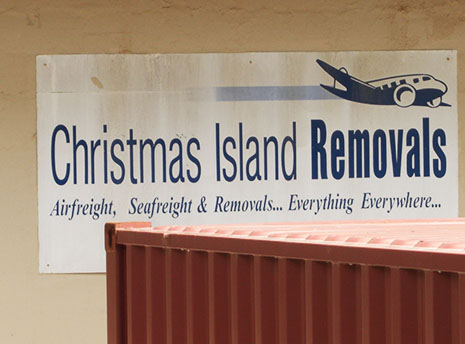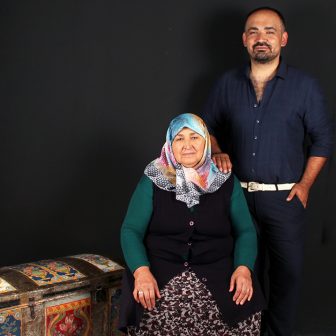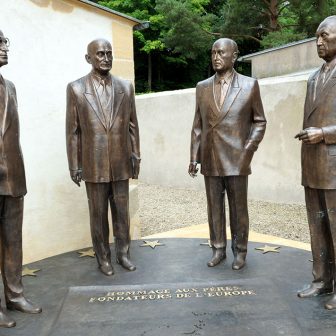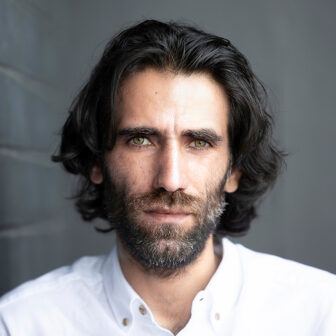CHRISTMAS ISLAND is a weird place to begin with: a big rock in the Indian Ocean, much of it covered in high grade phosphate, inhabited by about 100 million red crabs. The island’s peculiarities are not limited to its natural environment. People travelling to this Australian outpost on a direct flight from Perth depart from the international terminal and go through customs at both ends of the journey. But surely the strangest feature of Christmas Island, a landmark that reminded me of an oversized version of the new elephant enclosure at the Melbourne Zoo, is a state-of-the-art, high security immigration detention centre, surrounded by sea on three sides and a national park on the fourth.
In fact Christmas Island currently houses four detention facilities: the North West Point immigration detention centre, built by the Howard government for a staggering $400 million; Lilac and Aqua compounds, a comparatively cheap extension of the North West Point facility built by the Rudd government; the so-called Construction Camp at Phosphate Hill for families, unaccompanied minors and Indonesian crew, which makes use of the dongas used to house the workers building the North West Point centre; and another, smaller detention facility adjacent to the Construction Camp with demountables and tents for single men. The Department of Immigration and Citizenship currently holds more than 2400 detainees on the island.
As far as I could tell after guided tours of all four detention centres and meetings with detainees in three of the four facilities, the department is doing a good job on Christmas Island. There did not seem to be any tangible tension between detainees, on the one hand, and departmental officers and staff from SERCO, the company charged with running the facilities, on the other. These centres are a far cry from the notorious Woomera and Baxter desert camps set up by the Howard government.
That is not to say that the current situation is satisfactory. Far from it: the boats keep coming, the Christmas Island facilities are bursting at the seams, and the government does not seem to have a long-term plan. I was told that there is no scope for further extensions at North West Point. For some weeks now, to make space for new arrivals, detainees have been moved off the island and accommodated at the Leonora and Curtin facilities in Western Australia, at Villawood in Sydney, and at the Darwin immigration detention centre.
Detainees, guards, departmental officers, medical staff, teachers, members of the Australian League of Immigration Volunteers, Australian Federal Police and interpreters now outnumber Christmas Islanders more than two to one. The detention industry has come to make a far more significant contribution to the island’s economy than the phosphate mine, which had been the main rationale for settlement for more than a hundred years. While the immigration department’s presence on the island has obvious economic benefits, it also represents a strain on available resources, including water and housing.
It is expensive to run detention facilities in a place that is as far as could be from the Australian mainland, and 2623 kilometres from Perth. There are no market gardens on the island, so all food needs to be imported – as, of course, do all manufactured goods. While some islanders now work at the detention centres, the majority of staff come to the island in short stints. SERCO and departmental officers, for example, work in three- or six-week rotations and need to be flown to and from the island. Detainees must be evacuated to Perth if they require specialist medical attention. Scrutiny of the government’s operation, which is essential in a democracy, is difficult: there are no resident journalists or refugee lawyers.
The ludicrous situation of using detention facilities in this most remote place is partly a legacy of the Howard years. Under Howard the government lavished hundreds of millions of dollars on the new detention centre. Its buildings are not suitable for anything else – except, perhaps, for a Guantanamo-style high-security prison. So why not use them at a time when there is a need to accommodate asylum seekers?
Such reasoning is opportunistic, and it doesn’t necessarily make economic sense. By the time the additional costs of running facilities on Christmas Island are factored in, it may have been far cheaper to write off the white elephant and either establish a new centre on the mainland or use existing facilities (as the government has been doing in order to deal with the overflow from Christmas Island).
The absurdity of a detention centre thousands of kilometres off the Australian coast should not be blamed on John Howard alone. It is also, more importantly, a reflection of the dire state of Australia’s public debate about asylum seekers, which has its own absurdities.
CURRENTLY there are three main positions in that debate. There is the federal Coalition’s: Tony Abbott and his colleagues would like to return to temporary protection visas and the Pacific Solution (even though that’s not what they currently call it). Their policies hark back to the approach that proved to be both a long-term disaster (in terms of its human costs) and a short-term success (in terms of its electoral traction). The opposition can hardly draw on rational arguments in support of its policy, which feeds on and incites irrational fears of a country overrun by invaders from the north.
Then there’s the position championed by many refugee advocates and by much of the liberal media, warning of the dangers of a hardening of Australia’s response to asylum seekers. Advocates put forward two arguments, in particular: first, all asylum seekers have fled intolerable conditions and should not be returned to such conditions; and, second, asylum seekers, if resettled in Australia, make good citizens. Neither argument is particularly compelling. The first ignores the fact that those seeking asylum could and should be returned whence they came if they evidently do not meet the criteria of the 1951 Refugees Convention and if they are not exposed to any danger on account of being removed from Australia. Seeking asylum is not the same as being a refugee. The second argument is irrelevant: if a person is found to be a refugee, then she ought to be resettled regardless of how deserving she is otherwise. Whether somebody is lazy or has a disability or lacks intelligence or repeatedly fails the citizenship test or is unable to appreciate Australian Rules football should not come into the equation.
The third position – the government’s – has become something of a mystery. On 9 April, federal cabinet suspended the processing of applications of asylum seekers from Sri Lanka and Afghanistan – supposedly because “the changing circumstances in both these countries will make it more likely that visa applications will be refused.” The announcement suggested that by early July (in the case of Sri Lanka) or by early October (in the case of Afghanistan) the situation in those countries will have changed sufficiently to warrant the granting of fewer protection visas, and/or that it would take that long for reviews of those situations to be completed. The government implied that it expected reviews to be carried out soon by the United Nations High Commissioner for Refugees and that it would pay close attention to the latter’s advice. The UNHCR routinely reviews the situation in all refugee-producing countries, but it has made no suggestion that in the coming months assessments of the situations in Afghanistan and Sri Lanka will substantially differ from those available at present.
The suspension appears to have been a smokescreen. What the government did not say in early April was that by then, in its view, the situation in both Sri Lanka and Afghanistan had already changed substantially for the better. Since April, the number of approvals has dropped dramatically. It seems that the decline followed the introduction of Country and Policy Guidance Notes, which, according to the Department of Immigration, are to “assist decision makers by analysing country of origin information, providing a clear explanation of relevant policy and importantly, provide decision makers with specific, consistent instructions on investigating and assessing claims against the evidence provided in country of origin information.” According to a document issued by the department on 9 April, these notes “will be publicly available on the department’s website.” On Monday, two-and-a-half months after the policy was released, I was told by a departmental officer: “The reports are still being updated and it is my understanding the policy guidance notes will be released in due course.”
I suspect that in early April the government decided to grant fewer protection visas, particularly to applicants from Afghanistan and Sri Lanka, but not to publicise that decision. In the interests of not further upsetting one of its own core constituencies, it might have been hoping that the full impact of the decision (which was not based on a dramatically altered UNHCR assessment) would not become obvious until the end of the year – that is, until after the federal election – when the asylum seekers who are currently subject to the suspension policy will learn of the outcome of their applications. In the meantime, the government seems to be hoping that the suspension policy itself is perceived to be a tough measure it can cite whenever Tony Abbott accuses the government of being soft on border protection. The alternative would have been to counter the opposition’s criticism by referring to the declining approval rate. For all its faults, the Labor government has not yet sunk low enough to boast of every occasion when an asylum seeker’s protection claim is refused.
In itself, the suspension did not do anything – it has neither stopped the boats from coming nor was it apparently needed to give the department time to develop new guidelines. Judging by the latest rounds of decisions handed out to asylum seekers, these guidelines are already in place. To claim that the recent “negative assessments… support the government’s decision to suspend the processing” of claims by Sri Lankans and Afghans, as the department did earlier this month, is illogical: if many of those who arrived before 9 April are now told that their protection claims have been rejected, then there was no need to suspend the processing of applications from asylum seekers arriving after that date.
THE CHANGES to Australia’s asylum seeker processing, and the emphasis on the least consequential of those changes at the time when they were announced, are symptomatic of the government’s refugee policy. Neither the policy nor its implementation have been transparent. Since the boats starting coming again in 2008, the government has done little to explain exactly what it has been doing and why it has been doing it. If it ever had a case, then it argued it badly. It has not framed its policy with reference to the broader issue: the role countries such as Australia could or need to play in addressing the global phenomenon of forced migration. It has not talked about big picture solutions.
Soon after the 2007 election, the Labor government scrapped the Pacific Solution, abolished temporary protection visas, offered compensation to Cornelia Rau and granted a permanent visa to Robert Jovicic, the long-term Australian resident camping on the doorsteps of Australia’s embassy in Belgrade after he had been removed on character grounds. Two years ago, Senator Evans said that the government was committed to detention only as “a last resort” and “for the shortest practicable period.” Policy measures and public commitments signalled a complete overhaul of the Howard government’s punitive policies. They also gave grounds for hope: that at long last the Australian government would encourage an informed and wide-ranging debate about Australia’s response to refugees and asylum seekers, and provide leadership in such a debate. Senator Evans, who in my view is probably still the best immigration minister Labor has had, seemed to be the right person to facilitate such a debate. He appeared to have the clout and stature that would allow him to keep the prime minister’s office at bay, and the ability to look beyond the day-to-day management of boat arrivals. I now wonder whether I overestimated Evans’s capabilities, or whether I underestimated the extent to which Rudd and his staff would meddle in immigration matters.
We should have had a broader debate about Australia’s responsibilities as a regional power and its obligations as a wealthy nation. It should have been about the push factors that compel refugees and others to leave their homelands and risk their lives trying to reach Australia. It should have been about the history of Australia’s and Australians’ responses to refugees, and about lessons that could have been learnt from such a history. It should have been about the fears that have made a policy modelled in part on the proposals put forward first by Pauline Hanson so appealing. It should have been about the global refugee regime: the role of international organisations, the allocation of resettlement places, and intersections between foreign policy, security policy and refugee policy.
Such a debate could have helped Australians to appreciate that the situation is complex and that there are no easy solutions, that asylum seekers are neither disease-ridden terrorists nor angels, and that Australia’s current response cannot be but a stop-gap. An informed debate might even have generated ideas for novel solutions.
An informed and wide-ranging debate, coupled with a proper explanation of the government’s response to asylum seekers, may have allowed more Australians to see how irrational fears about Australia’s being swamped by “boat people” are. An open discussion about the background to the current policy, including its international legal and moral implications, could have stymied the opposition’s attempt to make a comparatively small number of asylum seekers a topic in the upcoming election campaign, and may therefore have made redundant the need for Labor to spout its own tough rhetoric, and to tighten its asylum seeker policy.
As happened in the case of the aborted emissions trading scheme, however, the government has shied away from kickstarting and leading a wide-ranging debate, although it was in an excellent position to do so in 2008 and 2009, when it was riding high in the polls and Australians expected initiatives that could be seen as visionary. A perfect opportunity was squandered. Now, of course, it is too late. That cowardice – and not the tightening of the asylum seeker processing regime, however problematic it is – is the government’s greatest failing.
As I left Christmas Island, I thought about the sense of wonder experienced by visitors to the island and by those who know about it only courtesy of David Attenborough or National Geographic. It is easy to marvel at the weirdness of nature when confronted with Christmas Island’s fauna. I wish we were more often able to look at government policies with the same curiosity and open-mindedness that we summon when watching a red crab crossing the road. By taking these policies for granted before either agreeing with or opposing them, we are unable to see how utterly weird some of them are. •




